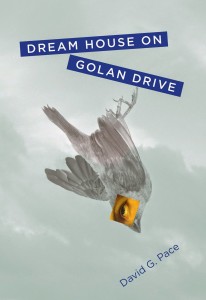Title: Dream House on Golan Drive
Author: David G. Pace
Publisher: Signature Books
Genre: Novel
Number of Pages: 296
Binding: Paperback
ISBN 978-1-56085-241-4
Price: $24.95
Reviewed by Catherine C. Peterson for the Association of Mormon Letters
David G. Pace’s “Dream House on Golan Drive” is a story framed in the Mormon uber-culture of Utah Valley, where Latter-day Saints labor fervently to exemplify Christianity through decency and service. The book follows Riley Hartley, who belongs to an “ideal” Mormon family and lives on the Provo bench, the stratified neighborhood above Brigham Young University where the vistas include tidy neighborhoods, orchards, the lake below and mountains beyond. His father, Gus Hartley, is an exemplary spiritual pillar who is a powerful speaker and advocate for intense prayer and personal revelation. Riley’s beauty queen mother, Joan, manages the big household and rearing of her many children in the spotlight of admiring eyes, valiantly living the life she believes to be her calling. Riley watches as the family survives a false accusation of adultery against his father and the bitter consequences. Riley falters after he faces his long held assumptions and belief, and begins to crumble under the pressures of the world.
The author has employed three props to frame the story:
The narrator, Zed
The bird metaphor
The chapter titles and headings
The story progresses via the narrative of Zedekiah (Zed), one of the 3 Nephites, who will never die, but roams the earth to help the children of God. He has the perspective of an old soul who has walked the earth since Christ’s visit. He is the teller of Riley’s story and the muse of his inspiration. He carries an ongoing conversation with the Wandering Jew (another earth wanderer of Hebrew legend). Zed is charged with watching over and protecting Riley who is bombarded with challenges both through observation and personal experience. Whether author Pace, via Zed, crosses the line as he casually relates Riley’s temple experiences must be determined by the judgment of the reader. On the other hand, the author gives voice to many of the paradoxes LDS people may face and questions that beg answers.
Woven through the story, birds become metaphors for us; flying and falling creatures of heaven dropped from an aerie in heaven into a nest from which we are launched to an inevitable fall and redemption. Images and allusions to birds such as a character with feathered hair, a beak-like nose, the pet birds, flutter throughout the book, reminding us of the lightness and fragility of our heavenly natures as we face the rigors of earth-life. In one scene of the book, birds are poignantly used to express Riley’s unbearable frustration that his life is not in sync. In a fury, Riley smashes the birdcages that house his wife’s two beloved pet birds, upon which she lavishes her love and affection. One survives, the other dies, and Riley’s wife asks him to preside at a Mormon-style grave dedication. The deceased bird, for whom Riley did not mourn, was quickly replaced, foreshadowing his divorce.
The chapter headings add layers of symbolism and include silhouettes of birds posed in various postures – diving, flying, alighting, communicating with another, slumping, hovering, hunching. They speak as heralds of our heavenly natures, our fall from grace and our ascension to our heavenly home. The chapter titles offer symbolic hints to the content. For example, the heading, “The Edsel,” hints of a trip toward a marriage doomed for breakdown and obsolescence at the get-go. “Empty Armor” shows Riley becoming undone, and beginning to shed the defenses he has built up while self-destructing, leading to a final reckoning.
As Riley Hartley struggles for peace and resolution we are carried through several universal themes that leave us with few answers and more questions. As I read the book so much was familiar. I grew up in Utah Valley and attended BYU contemporary with the setting of the story. Uncomfortable questions I have were brought up throughout. Parts of it felt edgy and irreverent, others exhilarating and vindicating. Don’t expect to read this book unscathed or untouched. The story is rife with the universal struggles between good and evil, sin and righteousness, culture and truth, strength and weakness, and dissonance between what we gain through experiential learning and rote imprinting. Thought provoking, and at times humorous and heart wrenching, “Dream House on Golan Drive” is a multi-layered and artfully presented story.

